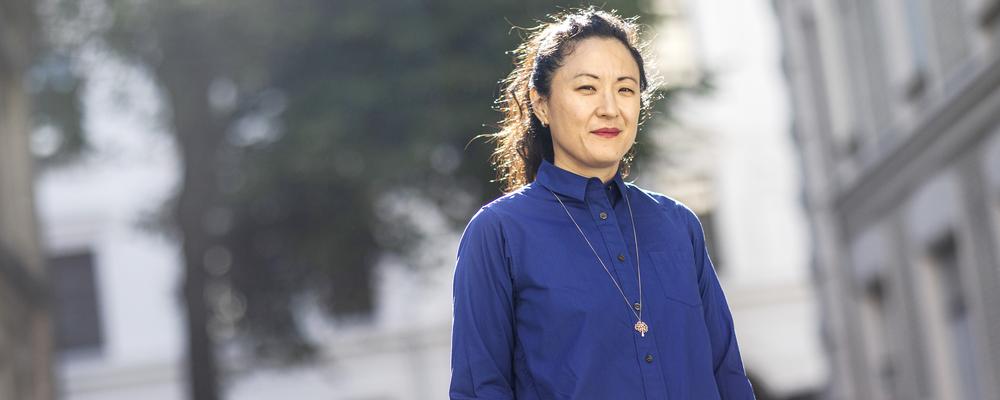In 2014, artist Jeuno Kim and her fellow artist Ewa Einhorn created Krabstadt, an imaginary place somewhere in Scandinavia where society sends its outcasts and undesirable citizens. When the duo travelled around to international film festivals and showed their animated feminist short films – and tried to pitch Krabstadt as a television series – they were often told how perfectly their fictive, artistic world would work as a video game. That assessment could hardly have found a person who is less enthusiastic about video games than Jeuno Kim.
‘I just thought, well, maybe we should make a video game where everything just blows up’, says Kim. ‘And then a message pops up that tells the kids that they ought to do something else, like read a book. I don’t like video games so much. There is something with screens that I think is ... provocative. All kinds of digital media are provocative’, says Kim. Until recently, she was Programme Director for the Bachelor of Fine Art programme at HDK-Valand. She got her own training as an artist in the United States at the University of Illinois at Chicago.
Despite their scepticism, or perhaps because of their scepticism, in the summer of 2020 Kim and Einhorn were at work creating a Krabstadt video game called Krabstadt Buttons – or to be more precise, a hybrid between game and animated film. At the centre of the action stands Arrabbiata, a volcano with something of an anger management problem. The player’s mission is to try to channel the volcano’s wrath in a constructive way. To find inspiration for the game’s storyline, they have looked to an area to which presumably few game developers have paid much attention.
‘We looked at the political history of the Nordic region’, says Kim. ‘We especially make use of the history of Sweden’s Social Democratic Party and how it has harnessed citizens’ anger in pursuit of various social projects. There has been an awareness in the party that the population should not be allowed to become complacent, that it must be mobilised. How do you do that?’
Just as in the short film version of Krabstadt, humour and satire are going to be important features of Krabstadt Buttons. Kim notes that she has looked carefully at TV series like South Park and Family Guy, but also Tom & Jerry and the early Mickey Mouse movies. And in order to adapt the environments in the fictive city to a functional game world, they have dug deep into various archives. Among other things, they have found Japanese city plans from the sixteenth century that are fascinating in their alternative perspectives.
These are just some of the ingredients in Jeuno Kim and Ewa Einhorn’s game. But making a video game is not easy. Kim admits that they’ve already made ‘a million’ mistakes.
‘But that’s fine,’ she says. ‘I hope we make a lot of mistakes. Even though it’s very scary to fail, it’s still an important part of the research.’
And this is fundamentally about research. Artistic research. Because out of Kim’s scepticism toward video games and screens was born an idea for a research project. It was a strong idea. In October 2019, the Swedish Research Council awarded a three-year grant of 4.4 million SEK to Kim and Einhorn’s project Touché: Animated Images as Knowledge.
The point of departure for the project is that video games are everywhere today and are easily accessible. And games are no longer only about entertainment. They are increasingly used as news media channels and teaching tools. So video games are being used by people to learn things. They convey images. Jeuno Kim thinks there is good reason to explore that aspect.
‘I’m not saying that people shouldn’t use screens or play video games,’ she says, ‘but we have to become more aware of how the digital world shapes our lives. As games influence how we learn things more and more, they have a direct impact on one of society’s cornerstones: the acquisition of knowledge. Therefore we must ask ourselves what images are being used, and especially what stereotypes are being reproduced through games and animated pictures. And of course that is our speciality: discussing images and the creation of images.’
Kim thinks it is important for her to have a deep understanding of what she wants to criticise. She wants to get to know the conventions of the video game industry. Thus, building a game of her own has become one element in her process of acquiring knowledge. In addition to her research partner, Ewa Einhorn, Kim is getting assistance from a Danish game developer duo and a number of animators, musicians and the actors who do the voices for the game’s characters.
‘We hope to have a beta version ready soon. But of course this is not going to be any kind of sophisticated game. 4.4 million SEK is nothing in the game world. If we compare to the film world, what we’re doing is maybe something like a small documentary film with one camera operator, one sound technician and one editor’, Kim laughs. She explains that many parts of her professional and academic backgrounds have come together in this project.
‘I have always drawn and I also work with performance. I’m also a classically trained pianist – that was my first degree – and so I’m very interested in sound. You could probably say that the project combines all this: pictures and sound – and action.’
It is too soon to say what conclusions Kim will draw about video games and animated images in games.
‘I’m not interested in being sanctimonious or dogmatic. I don’t think it’s interesting to tell people what they should do and not do. But I hope that we can contribute something to the discourse in the field of video games with our research, our observations and our analysis.
Written by Johan Kollén, journalist


